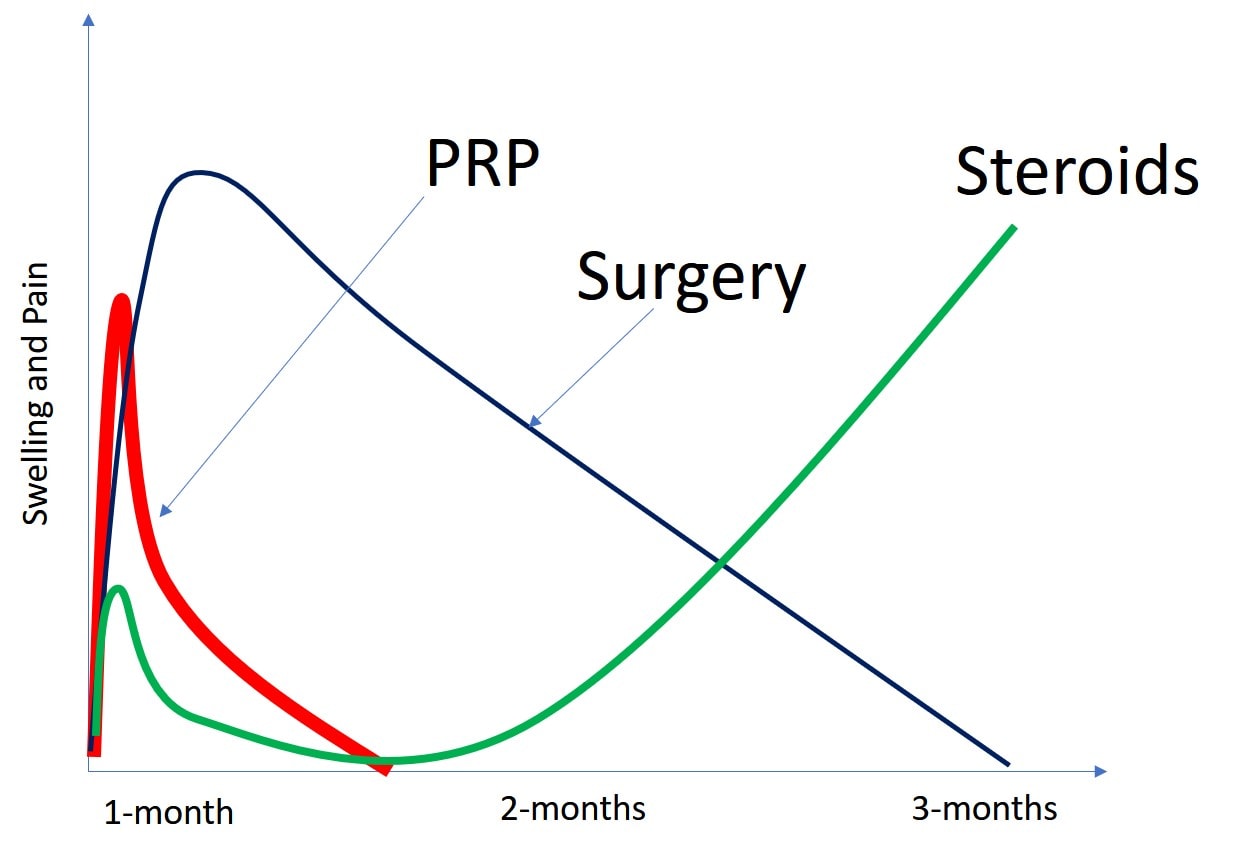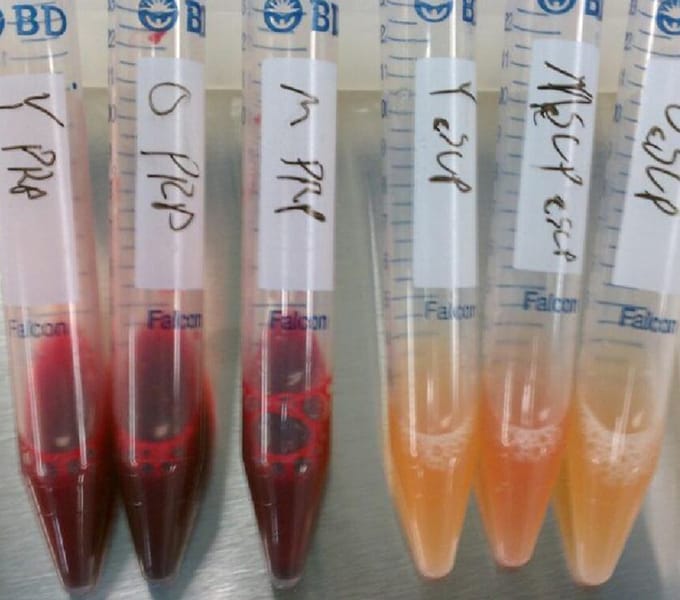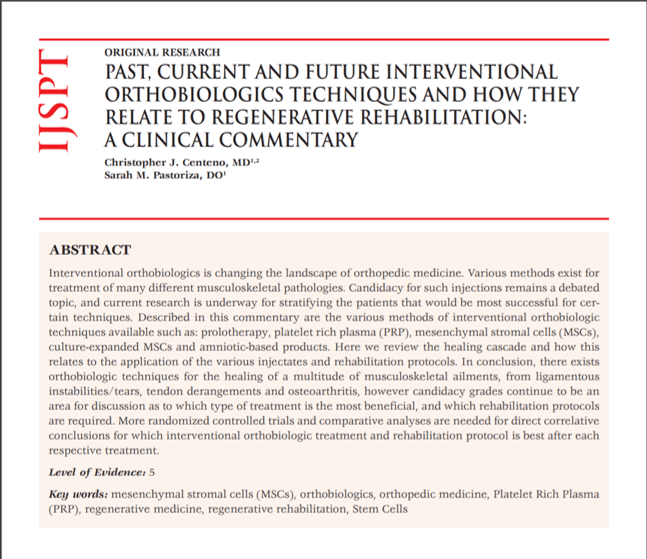What’s the Average Recovery Time After a PRP Injection?
On this page:
- How is a PRP injection different from a steroid shot?
- How long does it take to recover from a PRP injection?
- What can you not do after PRP therapy?
- Is the flare-up different for different types of PRP?
- What’s the success rate of PRP injections?
- Journal article on PRP injection recovery timeline
PRP stands for platelet-rich plasma which has become a hot treatment these past few years. What is the PRP injection recovery time like? How is a PRP injection different from a steroid shot or surgery and what does that mean for recovery?
How Is a PRP Injection Different From a Steroid Shot?
The idea behind PRP is that instead of injecting something that will reduce swelling in the short-term and inhibit healing (like steroid shots), the doctor is choosing to inject something which has the potential to heal. This is because the platelets in the PRP have healing growth factors that may help the damaged tissue mend (1). How is all of this different from steroids and surgery?
I graphed it all below, but PRP has an initial flare-up, then that goes away in 3-7 days and then the patient gradually gets better than baseline. For steroids it’s the opposite, with the patient feeling better quicker, but then the effects wear off over a number of weeks and the pain returns. Surgery has a longer pain duration for weeks and then the patient gets slowly better.

How Long Does It Take to Recover From PRP?
The PRP injection recovery time is fairly quick, with generally a few days of soreness and then improvement over time. For joint injections to treat arthritis, expect some soreness and possible swelling for 3-7 days. Then there’s usually a gradual improvement over a few weeks (2).
For tendons the soreness can last longer and the effects could take up to 3-4 months to be fully appreciated. For ligaments, there may be a “honeymoon” period of 1-2 weeks where loose ligaments are swollen and as such, provide better stability during that time, but then the initial swelling goes away and the pain and instability comes back (2). The full effects, like tendons, can take a few months to be seen. For more information, see my video below:
What Can You Not Do After PRP?
A big part of understanding PRP injection recovery time is knowing the activity limitations expected of you. The good news is that for the vast majority of situations where PRP is used, you generally don’t need to do anything special.
I tell my patients that this is an “Activity as Tolerated” recovery. That means that if you have pain from the injection, reduce your activities to keep the pain at about a 2/10. if you have no pain, then resume your normal activities, going lighter on work-outs while you listen to your body.
Is the Flare-Up Different for Different Types of PRP?

Also, realize that the degree of post-PRP injection flare-up can be due to your body’s own level of systemic inflammation and where the PRP was injected or how aggressively the procedure disrupted the tissues.
What’s the Success Rate of PRP Injections?
The success rate of PRP injections varies with what’s being treated. In general, the research so far shows the following:
- Mild to Moderate Knee Arthritis: 80% of patients report good results for 1-2 years. There is less success for shorter periods (usually a few months) for moderate to severe knee arthritis.
- Partial Tendon and Ligament Tears: Again, about 80% of patients report long-term results. Here, it’s possible that more than one injection may be needed. More severe complete tears are less likely to respond to PRP.
- Spine: While less is published here, we see good results of about 80% when the right patient are selected. In our experience, using PRP to just replace steroid injections into one specific area like epidural or the facet joints is less successful than using it more globally in the spine to inject many different parts of the spinal unit (3). For example, the ligaments, the muscles, epidural, and facets. We’ve even seen promising results in patients with spinal stenosis.
Our Journal Article on the PRP Injection Recovery Timeline
We published this paper on how rehabilitation and physical therapy is different when orthobiologic injections like PRP are used instead of surgery (5). The main thrust of the paper is that surgery causes the patient to regress in function, hence much of surgical rehab is just getting back to where you started.
However, for orthobiologic injections, the flare-up and loss of function are much less, so the focus is on fixing the biomechanical problems that caused the orthopedic problem.
The upshot? PRP injection recovery time is usually quick and much less than surgery. However, knowing what to expect based on what’s being treated is key.
__________________________________________________
References
(1) Le ADK, Enweze L, DeBaun MR, Dragoo JL. Current Clinical Recommendations for Use of Platelet-Rich Plasma. Curr Rev Musculoskelet Med. 2018;11(4):624-634. doi:10.1007/s12178-018-9527-7
(2) Xu Q, Chen J, Cheng L. Comparison of platelet rich plasma and corticosteroids in the management of lateral epicondylitis: A meta-analysis of randomized controlled trials. Int J Surg. 2019 Jul;67:37-46. doi:10.1016/j.ijsu.2019.05.003
(3) Singla V, Batra YK, Bharti N, Goni VG, Marwaha N. Steroid vs. Platelet-Rich Plasma in Ultrasound-Guided Sacroiliac Joint Injection for Chronic Low Back Pain. Pain Pract. 2017 Jul;17(6):782-791. doi:10.1111/papr.12526
(4) Wu J, Zhou J, Liu C1, Zhang J, Xiong W, Lv Y, Liu R, Wang R, Du Z, Zhang G, Liu Q. A Prospective Study Comparing Platelet-Rich Plasma and Local Anesthetic (LA)/Corticosteroid in Intra-Articular Injection for the Treatment of Lumbar Facet Joint Syndrome. Pain Pract. 2017 Sep;17(7):914-924. doi:10.1111/papr.12544
(5) Centeno CJ, Pastoriza SM. PAST, CURRENT AND FUTURE INTERVENTIONAL ORTHOBIOLOGICS TECHNIQUES AND HOW THEY RELATE TO REGENERATIVE REHABILITATION: A CLINICAL COMMENTARY. Int J Sports Phys Ther. 2020;15(2):301-325.
If you have questions or comments about this blog post, please email us at [email protected]
NOTE: This blog post provides general information to help the reader better understand regenerative medicine, musculoskeletal health, and related subjects. All content provided in this blog, website, or any linked materials, including text, graphics, images, patient profiles, outcomes, and information, are not intended and should not be considered or used as a substitute for medical advice, diagnosis, or treatment. Please always consult with a professional and certified healthcare provider to discuss if a treatment is right for you.
